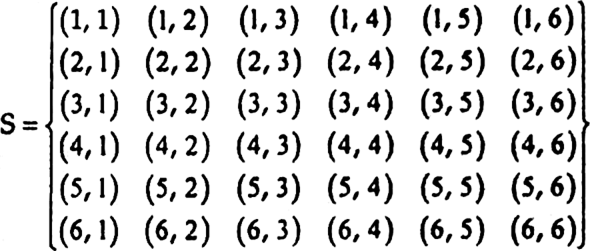 Short Answer Type
Short Answer TypeA die is thrown once. Find the probability of getting
(i) an odd number.
(ii) a number greater than 4.
(iii) seven.
A pair of dice is thrown once. Find the probability of getting a total of 5 on two dice.
Two dice are thrown simultaneously. What is the probability that
(i) 5 will not come up on either of them?
(ii) 5 will come up on at least one?
(iii) 5 will come at both dice?
Two dice are thrown simultaneously. Find the probability of getting :
(i) a sum less than 6 (ii) a sum less than 7
(iii) a sum more than 7 (iv) 8 as the sum
If two dice are thrown simultaneously, then possible outcomes(s) are 36. i.e., n(S)= 36
(i) Let E be the favourable outcomes of getting a sum less than 6, then
E= {(1,1),(1, 2), (l, 3), (1,4), (2, 1), (2, 2), (2, 3), (3, l), (3, 2), (4, l)}
⇒ n(E)= 10 Therefore,
P(E) = ![]()
(ii) Let F be the favourable outcomes of getting a sum less than 7.
F= {(1, 1), (1, 2), (1,3), (1,4), (1,5). (2, 1), (2, 2), (2, 3), (2, 4), (3, 1), (3, 2), (3, 3), (4,1), (4, 2), (5, 1)}
⇒ n( F)=15 Therefore,
P(F) = ![]()
(iii) Let G be the favourable outcomes of getting a sum more than 7, then
G = {(2, 6), (3, 5), (3, 6), (4, 4), (4, 5), (4, 6), (5, 3), (5, 4), (5, 5), (5, 6), (6, 2), (6, 3), (6, 4), (6, 5), (6, 6)1
⇒ n(G) = 15 Therefore,
P(G) = ![]()
(iv) Let H be the favourable outcomes of getting 8 as the sum. then
H = |(2, 6), (3, 5), (4, 4), (5, 3), (6, 2)}
⇒ n( H) = 6 Therefore.
P(H) = ![]()
A card is drawn from a pack of 52 playing cards. What is the probability that it is
(i) an ace
(ii) a face card
(iii) any card numbered from 2 to 10?
One card is drawn from a pack of 52 cards, each of the 52 cards being equally likely to be drawn. Find the probability that the card drawn is :
(i) red (ii) either red or king
(iii) red and a king (iv) a red face card
(v) ‘2’ of spades (vi) ‘10’ of a black suit.
